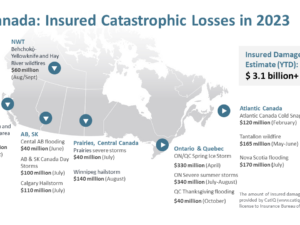Actuaries Climate Index
By Caterina Lindman, FCIA, FSA, Waterloo Region Leader, Citizens’ Climate Lobby
The Actuaries Climate Index (ACI) is an objective, quarterly, online measure of changes in climate extremes and sea level in Canada and the United States relative to the 30-year period of 1961–1990. This educational tool can help actuaries, public policymakers, educators, and the general public to gain a better understanding of climate impacts.
The ACI was developed by the four largest actuarial professional associations in North America: the American Academy of Actuaries, the Canadian Institute of Actuaries, the Casualty Actuarial Society, and the Society of Actuaries. The Climate Change Committee appointed by these organizations worked with climate scientists from Solterra Solutions, a consulting firm, to develop the ACI.
It was my work as chair of the Actuaries Climate Index Working Group that led to my interest in Citizens’ Climate Lobby. Our research helped me learn about climate change, and I felt called to go beyond the work of measuring climate change through the ACI. I wanted to influence public policy, because I came to the conclusion that individual actions to reduce emissions, while necessary, were not sufficient to address the issue. What was needed was collective action, and I was attracted not only to CCL’s policy, but also to how they went about building political will.
How it Works
The ACI measures climate extremes in Canada and the United States based on data, updated quarterly, in the six different index components from 1961 to winter 2016 below:
- High temperatures;
- Low temperatures;
- High winds;
- Precipitation;
- Drought; and
- Sea level
Each component is a measurement of the value today compared to the reference period of 1961 to 1990. A 30-year reference period is common in measuring climate, as it is long enough to exclude short-term trends. Higher index values point to an increase in the frequencies of extreme climate events by comparison to the 1961–1990 reference period. The index, with the exception of the sea level component, measures extremes rather than averages because the increase in extremes is more relevant to climate risk. This index is based on data collected by a wide network of meteorological stations[1] plus 76 tidal stations. Each component of the index is expressed in the number of standard deviations that the value today is greater than the value during the reference period. The ACI is the mean of the 6 components.
In the following illustration of ACI values, the five-year moving average, in black, is shown to help discern the emerging trend. S stands for sea level, D for drought, P for precipitation, T90 and -T10 stand for warm and cold extremes respectively, and W for wind.
What does the graph tell us? First of all, the graph shows a great variability, thus the need to look at climate over long periods to confirm trends. Second, despite fluctuations, it is clear that the ACI has generally been increasing after the end of the reference period in 1990. The clearest trends are seen in the sea level, high temperatures (T90), and less frequent cool temperatures (-T10). The wind power, precipitation, and drought components are more erratic.
The ACI tells us that an increased frequency of climate extremes can impact us in a variety of ways, which need to be taken seriously. Please consider exploring the Actuaries Climate Index, starting with the guided tour.
[1] GHCN (Global Historical Climatology Network)-Daily is an integrated, gridded database of daily climate summaries from land surface stations across the globe. The grids each cover a surface area of 2.5 degrees longitude by 2.5 degrees latitude, 275 km by 275 km at the equator.





